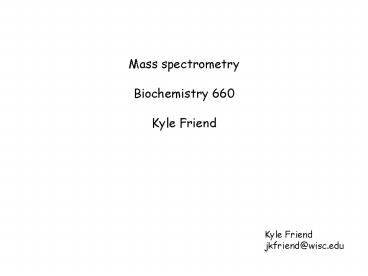Mass spectrometry Biochemistry 660 Kyle Friend - PowerPoint PPT Presentation
1 / 35
Title:
Mass spectrometry Biochemistry 660 Kyle Friend
Description:
Zoom scan (to determine charge) MS/MS scan (optional peptide sequence) Mass Analyzers ... Zoom scan. m/z (m 1)/z (m 2)/z (m 3)/z. Mass Analyzers. Precursor ... – PowerPoint PPT presentation
Number of Views:76
Avg rating:3.0/5.0
Title: Mass spectrometry Biochemistry 660 Kyle Friend
1
Mass spectrometryBiochemistry 660Kyle Friend
Kyle Friend jkfriend_at_wisc.edu
2
What is mass spec used for?
Protein identification
3
Outline
- Mass spec components
- Mass spec analysis
- Applications
4
Core Mass Spec Components
- Ionization source
- Mass analyzer
- Detector
5
Ionization SourcesElectrospray
1.5-2 keV
-
-
M
M
M
M
To Mass Analyzer
M
M
M
M
-
-
ES Capillary Negative ions are retained
Solvent evaporates Positive ions repel and are
ejected
6
Ionization SourcesMALDI(Matrix-Assisted Laser
Desorption Ionization)
Analyte-matrix spot
Laser
Analyte ion
To Mass Analyzer
Matrix ion
Cation
Sample plate
7
Mass AnalyzersLTQ(Linear Trap Quadrupole)
Pre-filter
Quadrupole
To Detector
8
Mass AnalyzersICR(Ion Cyclotron Resonance)
Detects harmonic ion signal
9
Mass AnalyzersOrbitrap
10
Mass AnalyzersToF(Time of Flight)
Detector
Ion Reflector
Ion Source
11
Ion Detector
For LTQ or MALDI 1. Ion induces current in
detector or Ion strikes surface to generate
current 2. Signal increased by amplification ICR
or Orbitrap 1. Resonant ions induce oscillating
signal 2. Fourier transform converts signal
12
Outline
- Mass spec components
- Mass spec analysis
- Applications
13
Mass AnalyzersSteps (Bottom-Up Mass Spec)
- Precursor scan (gives peptide fingerprint)
- Zoom scan (to determine charge)
- MS/MS scan (optional peptide sequence)
14
Mass Analyzersm/z (or m/q) ratio
F qB/2pm
F force q charge B magnetic field m
mass Mass spectrometers determine an ion's m/z
numerical value
15
Mass AnalyzersPrecursor scan
n.b. all values are given as m/z ratio
16
Mass AnalyzersZoom scan
17
Mass AnalyzersPrecursor scan (peptide
fingerprint)
z4 m1898
z3 m1896
z3 m1566
z2 m1565
z2 m1922
18
Protein Identification from Peptide Fingerprint
1. Searchable database created 2. Database
"digested" for peptide fragments 3. Algorithm
matches query peptide fragments against the
database
Protein 3
Protein 2
Protein 4
Protein 1
m
m
m
m
Query Protein
m
19
Reasons for MS/MS
- No genome sequence
- Genome is complex
- Post-translational modifications
- Unambiguous assignments
20
MS/MS AnalysisCollision Induced Dissociation
(CID)
Peptides bombarded against inert gas
(N2) Collision cleaves amide bond (b and y ions)
b2
b3
b1
y1
y2
y3
21
MS/MS AnalysisElectron Capture Dissociation (ECD)
Peptides bombarded with electrons Captured
electron generates c and z ions (Great for
phosphorylation sites)
c2
c3
c1
c4
z2
z1
z3
z4
22
How to use the toolkit
LTQ ICR ToF
Mass accuracy Resolution Sensitivity Dynamic
range Identification Quantitation Throughput
Adapted from B. Domon and R. Aebersold Science
2006 312 212-217
23
Unfractionated Precursor Scan
24
Chromatography Separates Individual Peptides for
Easier Analysis (LC-MS/MS)
25
Data interpretationSearch Algorithms
- SEQUEST
- Eng, McCormack, Yates (1994) J. Amer. Soc. Mass.
Spectrom. 5 976-989. - MASCOT (FREE! On a limited basis)
- www.matrixscience.com
- Perkins, Pappin, Creasy, Cottrell (1999)
Electrophoresis, 20 3551-3567. - OMSSA (FREE and Open Source!)
- Geer, Markey, Kowalak, Wagner, Xu, Maynard, Yang,
Shi, Bryant (2004) J. Proteome Res. 3 958-964. - X!Tandem (FREE and Open Source!)
- Craig, Beavis (2004) Bioinformatics,
201466-1467. - Spectrum Mill
- Chalkley, Baker, Huang, Hansen, Allen, Rexach,
Burlingame (2005) Mol. Cell. Proteom.
41194-1204.
- How search algorithms generally work
- Peptide fingerprints matched against database
- Matching peptide(s) matched against the MS/MS
scan - Best fit assigned score
- a. Number predicted ions detected
- b. Deviation between predicted and experimental
ion masses - c. Detected ion signal relative to background
26
Data interpretation
Pretty
Not so pretty
Has 26/30 possible ions (b and y)
Has 6/12 possible ions (b and y)
27
Outline
- Mass spec components
- Mass spec analysis
- Applications
28
Mass spec applications
Protein identification
29
Protein identification
Single protein in solution 1. Avoid ionic
detergents and all detergents if possible.
- What to look for in a paper
- How many unique peptides?
- Sequence coverage?
- Identity confirmed?
30
Sites of post-translational modification
- Phosphorylation
- Can be difficult to i.d. using CID.
- ECD works very well.
- Lysine or Arginine modification
- Consider which enzyme to use for digestion.
- What to look for in a paper
- Mass spec resolution?
- MS/MS data?
31
Top-down mass spec
32
Quantitation
- Number of peptides
- Simple
- Unreliable
- What to look for in a SILAC paper
- Steps prior to mass spec analysis?
- Number of peptides?
- 3. Threshold for data inclusion?
33
Proteomics
34
Proteomics, LC-MS/MS on steroids
- Identical to LC-MS/MS, but with additional column
steps - Usually requires high resolution mass spec (whole
genome studies)
- What to look for in a paper
- How many unique peptides?
- Sequence coverage?
- Identity confirmed?
35
Mass Spectrometry at UW-Madison
- Biophysics Instrumentation Facility
- Darryl McClaslin
- bifmaster_at_biochem.wisc.edu
- Chemistry Dept. Mass Spectrometry Facility
- Martha Vestling
- vestling_at_chem.wisc.edu
- Biotechnology Center Mass Spectrometry and
Proteomics Facility - Amy Harms
- harms_at_biotech.wisc.edu
- Human Proteomics Program
- Ying Ge
- yge_at_physiology.wisc.edu
- School of Pharmacy Mass Spectrometry Facility
- Cameron Scarlett
- cscarlett_at_pharmacy.wisc.edu































